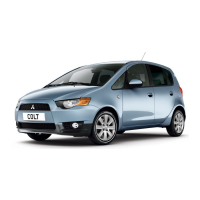
Do you have a question about the Mitsubishi XPANDER 2024 and is the answer not in the manual?
| Brand | Mitsubishi |
|---|---|
| Model | XPANDER 2024 |
| Category | Automobile |
| Language | English |
Identifies XPANDER/XPANDER CROSS via "HYBRID EV" marks.
Shows the locations of high voltage wiring cables within the vehicle.
Identifies the locations of SRS airbags and related components.
Provides exterior dimensions for the non-SUV variant.
Provides exterior dimensions for the SUV variant.
How to determine if the vehicle's hybrid system is active or not.
Specifies safe locations for using jacks or lifts on the vehicle.
Procedure for securing the vehicle using wheel chocks.
Method for stabilizing the vehicle using blocks.
Using prop tools to stabilize a rolled-over vehicle.
Using various methods to stabilize an overturned vehicle.
Explains how the high voltage circuit is insulated and covered.
How to disconnect the high voltage circuit using the service plug.
Warnings and PPE requirements for rescuing passengers from HEV.
Information on operating power windows and door locks.
Steps to apply the electric parking brake.
Procedures for releasing the electric parking brake.
Conditions for automatic release of the electric parking brake.
Step-by-step guide to open the vehicle's hood.
Instructions for opening and closing the vehicle's tailgate.
How to open the tailgate from inside, especially with a discharged battery.
Procedure for safely disconnecting the 12V auxiliary battery negative terminal.
Steps to remove the "Power unit control" fuse for safety.
Detailed procedure for removing the service plug to shut down high voltage.
Identification of laminated and tempered glass types in windows.
How to adjust the vehicle's seats and steering wheel.
Identifies locations of high-tensile and ultra-high-tensile steel panels.
Specifies areas where cutting is safe and unsafe due to hazards.
Techniques for opening doors using rescue tools like spreaders or cutters.
Using rams to create space for occupants in crushed vehicles.
Guidelines for extinguishing vehicle fires, including warnings.
Recommended agents (ABC powder, water) and safety distances for fire fighting.
Lists vehicle fluids, their capacities, and colors.
Information on flammable and flame-retardant substances in the vehicle.
Details about the lithium-ion drive battery, its voltage, and operation.
Safety precautions and risks associated with high voltage during normal operation.
Hazards related to the drive battery in case of a collision.
Information on electrolyte leaks, their properties, and handling precautions.
Precautions and procedures for submerged vehicles due to water hazards.
Steps for rescuing occupants and inspecting vehicles after submersion.
Flowchart to guide the disconnection of the high voltage circuit.
Summary of procedures for disconnecting the high voltage circuit.
Steps for discharging the drive battery if damaged or submerged.
Detailed process for discharging the drive battery using water injection.
Guidelines for transporting the vehicle, especially on flatbed trucks.
Instructions for towing the vehicle in emergency situations.
Warning about 12V battery discharge and performance issues during towing.
Cautionary advice on towing speed and distance to prevent damage.
Steps to manually release the electric parking brake in an emergency.
Shows locations of SRS air bag modules and pre-tensioners.
Explains caution labels related to SRS components.
How the SRS ECU uses impact sensors to deploy airbags and pre-tensioners.
Details on the driver's air bag module construction and inflation.
Details on the passenger's air bag module construction and inflation.
Location and function of the front impact sensor.
Function and components of the seat belt pre-tensioner.
Role of the SRS-ECU in collision detection and system activation.
Illustrates the location of major high voltage components in the vehicle.
Details on the drive battery's construction, voltage, and operation.
Explains the function and location of the service plug for safety.
Describes how battery performance changes with use and temperature.
Advice on long-term storage and handling of the drive battery.
Steps to remove the front drive battery terminal cover.
How to disconnect the drive battery cable terminals.
Instruction to prepare a container for collecting battery drainage.
Instructions for drilling holes to drain accumulated water.
Procedure for filling the drive battery tray with water.
Instruction to wait after filling, noting hydrogen generation.
How to drill holes to drain water from the drive battery tray.
Guidance on proper disposal of the drive battery.











